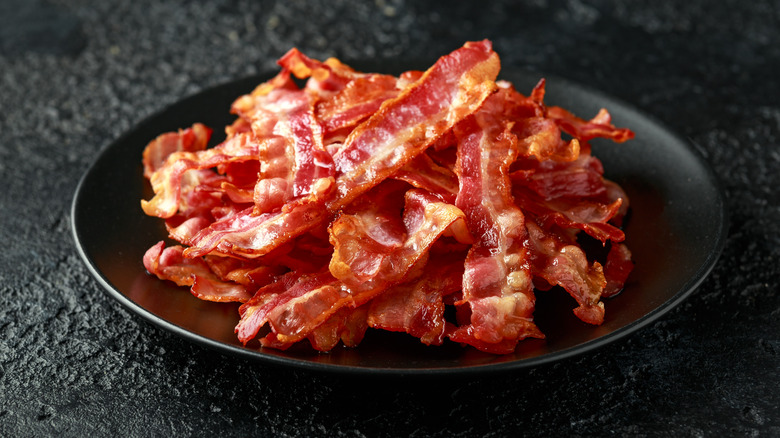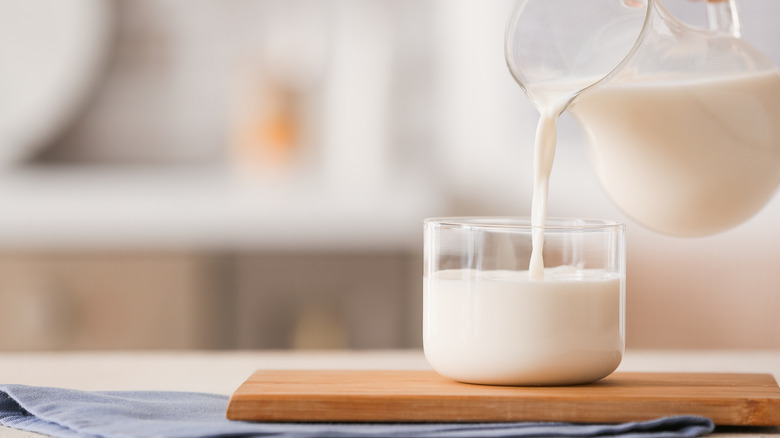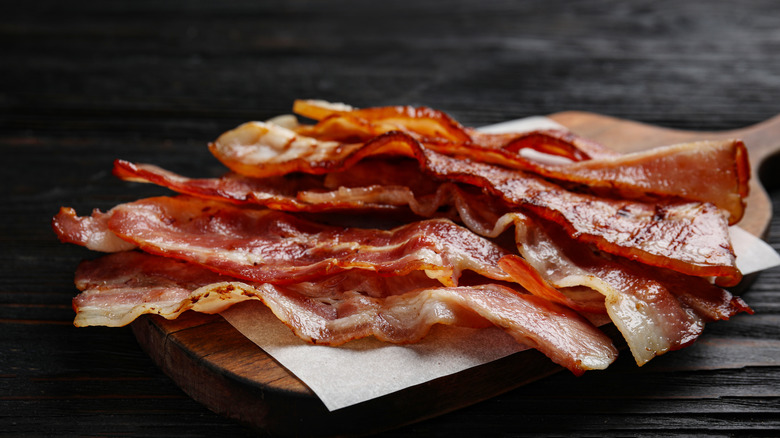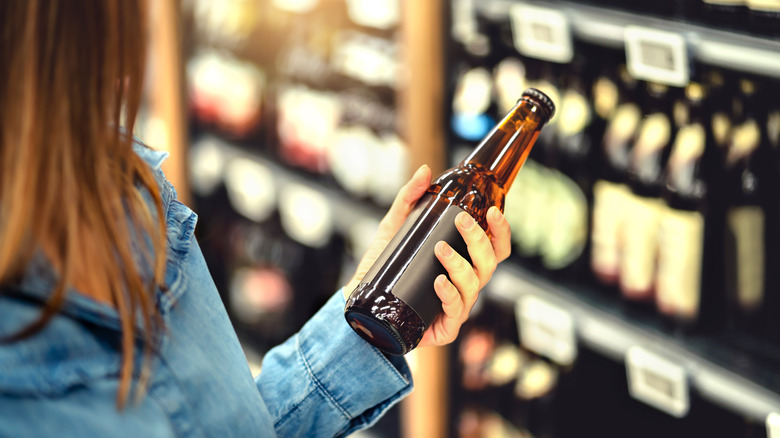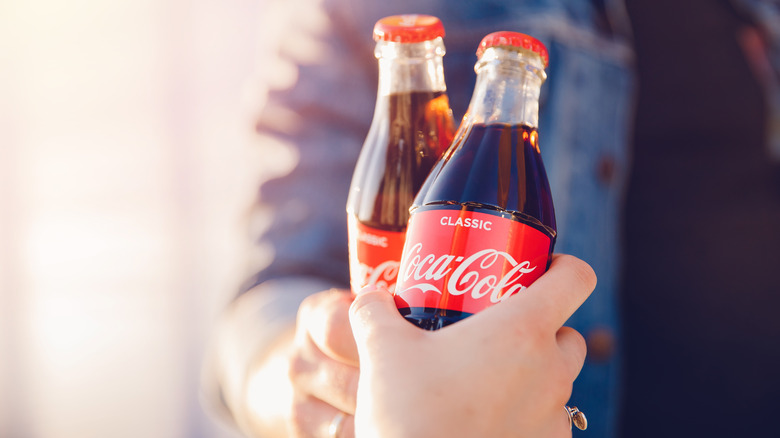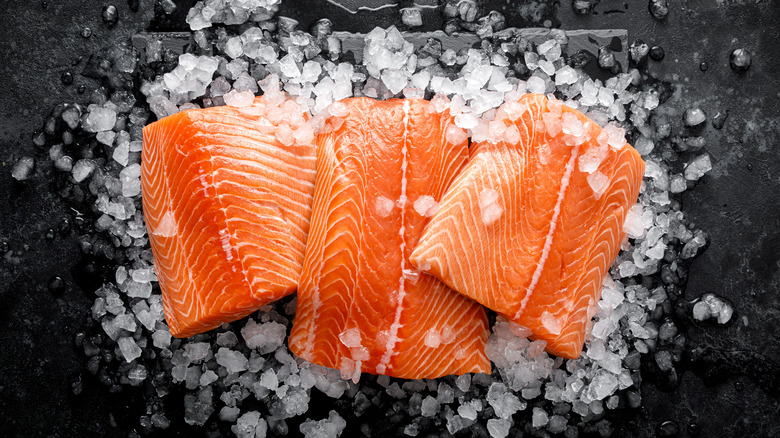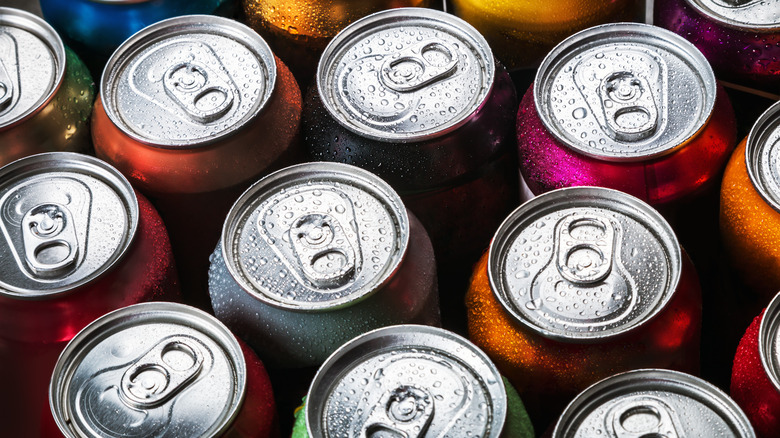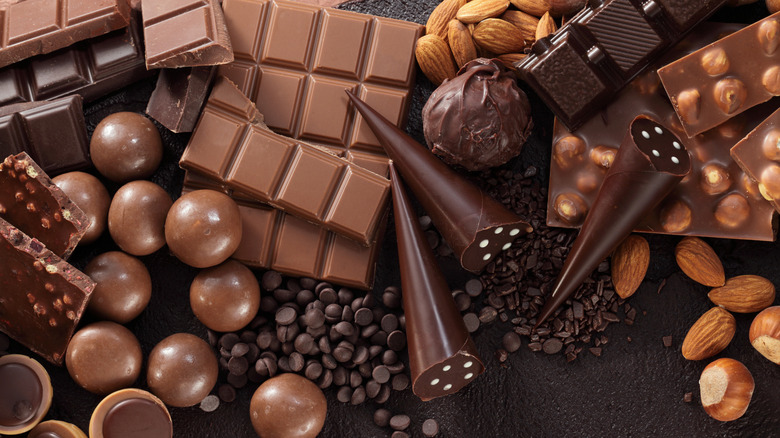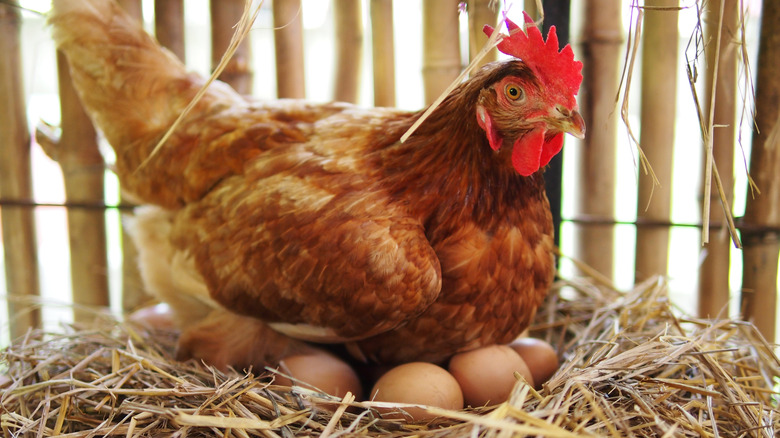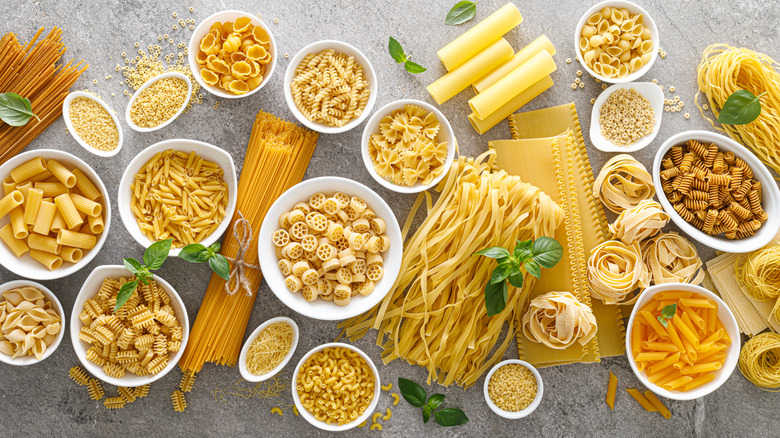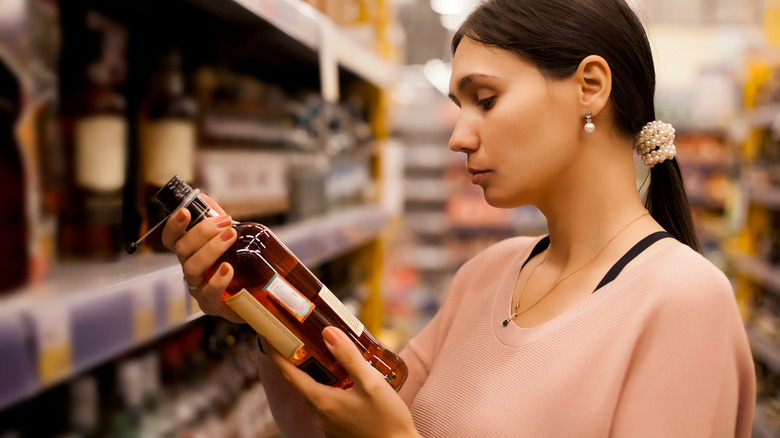Food Shortages We Could See In 2022
Let's be honest here: 2020 kicked off a decade that just seems like one cruel joke after another. Life for pretty much everyone went through a seismic shift with the arrival of a global pandemic, and with it came the shortages. Unfortunately, that's continued through 2021, and bad news, folks: It looks like 2022 will be the same way. In late 2021, Bloomberg took a look at the food shortages that were causing some serious chaos across the U.S. Grocery stores were warning of the possibility that shelves were going to look bare in places and telling customers not to be surprised if they had trouble getting certain things.
Albertsons' CEO Vivek Sankaran said, "I never imagined that we'd be here in October 2021 talking about supply-chain problems, but it's a reality. Any given day, you're going to have something missing in our stores, and it's across categories." Other retailers were having similar problems, and around the same time, they were recommending that people get their holiday shopping started early. Some Canadian retailers were already telling customers — in October! — that they were out of luck for certain toys, and shortages are projected to continue into 2022 (via CTV). What's going to continue to be scarce? Let's talk about what we're looking at.
Milk and dairy
Among the problems Bloomberg found was a shortage of milk going to public schools in places like Denver, and it turns out that's not an isolated incident. The problem? It's not the cows. In November, U.S. Foods reported that prices were going to be on the rise, largely due to supply chain difficulties and labor shortages that were causing a bottleneck in the chain. It was a problem echoed by AGWeb, who noted that the entire industry was being impacted by a shortage in labor nearly across the board. From processing facilities and dairy plants to drivers, Daily Dairy Report analyst Monica Ganley told AGWeb that "while dairy products are plentiful for now, these issues could work to keep markets tight in coming weeks."
It's a problem that's not restricted to just the U.S. In October 2021, Sky News reported that U.K. dairy farmers had been forced to dump tens of thousands of liters of milk — with one farmer disposing of 40,000 liters over the course of two months — because the nation faces a driver shortage so severe there just hasn't been anyone available to pick up the milk. Looking ahead to 2022, even Ireland is facing some serious problems: The Irish Examiner says that the consequences of a 65% drop in applicants looking for jobs in the dairy sector are going to be devastating.
Pork and bacon
The Miami Herald says there technically isn't a shortage in pork and bacon yet, but there are all kinds of things causing all kinds of issues. It's making prices skyrocket, and it's leaving things a little more precarious than bacon lovers might want. These problems are hitting from beginning to end: Rising feed prices mean raising pigs is getting more expensive, and while consumer demand is rising, there are still issues in getting the supply chain to run smoothly and get the product onto store shelves.
Things are even more dire in the U.K., where Brexit has caused so many labor shortages in the transportation industry and in meat processing plants that farmers are being forced to cull healthy animals that would age out of usefulness before abattoirs are able to handle them. According to Sky News, as many as 150,000 animals could be destroyed, leaving farmers in tears. Pig Progress says there's another thing that's likely to impact the availability of your favorite pork products. Even as COVID-19 caused a whole slew of problems for humans, a new strain of something called the Porcine Reproductive and Respiratory Syndrome (PRRS) virus devastated U.S., herds, leading to the deaths of up to 35% of female pigs and piglets.
Craft beers
Love craft beers? Look forward to picking up a few special bottles to celebrate a Friday night? It might get a little more difficult to get your favorites come 2022. The problem is twofold, and it starts with carbon dioxide (CO2). That, of course, is what makes beer fizzy, but according to Politics Home, it's going to get harder and harder for small-scale breweries to source CO2. While large-scale breweries tend to have the facilities to contain the CO2 given off during the manufacturing process and use that for carbonation, many smaller organizations don't have that tech. They need to buy in their CO2, and that's been in short supply since the start of the pandemic.
Why? Because, says Reuters, the CO2 industry is reliant on ethanol production, which is in turn connected to gasoline production. Demand for gas dropped drastically during 2020, as did the demand for ethanol, and ultimately that led to dwindling supplies of CO2.
The second part of the problem is a packaging one: According to Beverage Dynamics, everything from glass and aluminum to labels, corks, and caps is in short supply. Robert Catalano, CIO of a packaging company called The Spearhead Group, explained in late 2021, "It used to be about long-term planning. Now, most conversations are fire drills."
Coca-Cola
Prefer Coke to Pepsi? If you do, it's entirely possible 2022 will be the year you'll need to broaden your horizons. When James Quincey, CEO of Coca-Cola, spoke with CNBC in October of 2021, he said that they were pretty sure there were going to be "sporadic" shortages in the coming year. Quincy told CNBC, "My analogy would be it's a bit like an earthquake. You get further shock waves coming though, but they tend to be of diminishing magnitude."
As with other foodstuffs, Coke has been getting hit with major supply chain issues, along with higher costs on the back end from things like rising gas costs and labor shortages. It's bad enough at times that he likened troubleshooting to "a game of whack-a-mole."
Pepsi, on the other hand, seems to be doing a little better. While Front Office Sports confirms that yes, they've been struggling with the same supply chain problems and a lack of plastic bottles, they don't foresee the problems getting so bad that the difficulties will be reflected on store shelves.
Salmon
Salmon is one of the world's most popular fish, and about 40% of the global supply of wild salmon comes from Alaska. There's bad news, though: According to Bloomberg, stocks of wild salmon plummeted in 2020, putting a serious hurt on the food supply. According to the Alaska Seafood Marketing Institute, those numbers did return to normal in 2021.
But fish, say Alaska fishermen, aren't just getting fewer; they're getting smaller — and it all has to do with a looming global catastrophe. Sitka Salmon Shares fisherman Eric Jordan told Bloomberg, "Climate change isn't a theory to me. I deal with it every trip. It's here. It's happening."
And it's bad — climate change has been confirmed to be a major factor in the decline of wild salmon, which have dropped from past numbers of around 2 million to fewer than 430,000.
It's also worth mentioning that while this salmon shortage is unfortunate for many people, it's downright devastating for Alaska's native peoples. Groups like the Yupiit have relied on salmon for generations — not only is it one of the few reliable food sources for many, but it's a part of their cultural heritage. When Civil Eats spoke to Serena Fitka, the head of the Yukon River Drainage Fisheries Association, she described how terrifying it's been: "People came to me and said, 'I don't know what to do.'" That was echoed by the Tanana Chiefs Conference tribal resource manager Ben Stevens, who told them, "We have discerned a deeper sense of pain than we have ever seen before. The people are scared to totally different levels."
Coffee
The world needs all the help that it can get, that's no secret. Coffee at least makes things a little bit better, but that's right, there's bad news here, too.
In July 2021, The Wall Street Journal reported that there was a massive problem with that year's coffee harvest. Prices were going through the roof as one of the world's biggest coffee growers and exporters, Brazil, was facing what was described as "one of its worst droughts in almost a century." Coffee harvests had already been forecasted to be bad, but they were way worse than expected. Between just two companies, Rabobank and Volcafe, there was a decline of around 40 million bags.
By September, ABC News was reporting that the problem was just getting worse. Severe frost had added to Brazil's problems, while other climate-related disasters didn't help matters either. Prices continued to go up, but experts say that it's going to get to the point where that's not even going to matter — the coffee just isn't going to be there to sell. The forecasted coffee shortage is expected to last at least three years ... and that's just for starters.
Anything in an aluminum can
The pandemic ruined a lot of things, and one of the supply chain issues that's proving to be a continuing problem is sourcing aluminum cans. According to WasteDive, beverage manufacturers in particular have had to scale back production to fall in line with the number of cans they can source, and it's projected to be a continued problem not just through 2022, but into 2023.
Quartz took an in-depth look at the problem in September 2021 and found that not only was it a supply problem, but it was a demand problem, too. During and after the pandemic, people had discovered that they could drink a beer from the comfort of their own homes instead of going out and paying twice as much for that same beer, and demand skyrocketed. Add in the increasing popularity of things like hard seltzers, energy drinks, cocktails-in-a-can, and other canned foods, and that's all aluminum that has to come from somewhere.
And yes, that supply problem? That's got a surprising source: China. China's crackdown on energy usage in an attempt to be more environmentally friendly has resulted in a shortage of aluminum, and experts say it's impossible to tell how long the shortage will actually last.
Chocolate
In April of 2021, NASDAQ was already forecasting a deficit in global chocolate stores. Even though the chocolate harvest from the past year had been enough to leave the industry sitting with a comfortable surplus, demand for chocolate during the pandemic skyrocketed and quickly wiped out supplies.
The Centre for the Promotion of Imports from the Netherland Enterprise Agency explained what's going on here, and it goes back to COVID-19. While an uncertain economy put an end to a lot of spending on luxury items, chocolate was one of those things that people could still affordably enjoy — and they did. (It also had the benefit of being one of the luxuries available in one of the few places still open for business: grocery stores.) That's led to demand running ahead of supply, and ZME Science says it's probably just going to get worse.
There's a whole bunch of reasons why chocolate just might end up back on the "unaffordable and unattainable luxury" list of things, and it's scary stuff. The world's biggest chocolate-producing regions are suffering from not just political turmoil, but from disease outbreaks that include Ebola. Add in weather patterns and the fact that countries that previously produced their own chocolate — like Brazil — have seen such a rise in demand that they're now importing as well as producing, and you might want to rethink your reliance on chocolate.
Poultry and eggs
It's no secret that restaurants were hard-hit by the closures and restrictions of the pandemic, and according to Small Business Trends, they're going to continue to struggle — particularly those that rely on a chicken-centric menu. Chicken shortages — driven by devastating winter storms and pandemic-related shutdowns at processing plants — shaped a huge part of the culinary landscape of 2021, forcing countless restaurants to either rethink their menus or rethink their pricing. Even major chains needed to reevaluate, and suppliers are telling many of their end users that they should probably expect shortages to continue into 2022.
It's also entirely possible that 2022 is going to bring some major egg shortages, particularly and specifically in Massachusetts. It's being called "Egg Armageddon," says Food Safety News, and it has to do with 2016 legislation that's taking effect on January 1, 2022. Previously, egg-laying hens could be kept in enclosures that gave them between 6 and 12 square inches of floor space, but with new laws that bring the state more in line with most of the U.S., that's going up to 1.5 square feet of space for each hen. It's good news for the animals, but it's also putting some serious pressure on farmers who won't be able to produce if they can't provide for their hens.
Bottom line? Adapt, or face major shortages.
Pasta and other wheat products
Pasta was one of the in-demand items that customers sort of got used to seeing missing from grocery store shelves during the pandemic. It's versatile, has a long shelf life, and it's super easy, so it makes sense that people would want to stock up. Unfortunately, MSN says that 2022 is likely to bring similarly bare shelves.
This time, it's because of the world's changing climate and the impact it's having on durum wheat crops. Farmers in Europe are fighting heavier-than-normal rains, while Canadian farmers are struggling with heat and drought. In late 2021, industry unions released an official statement (via CCTN) saying "Climate change is endangering the pasta market," and that's a bigger deal than it might seem at first glance. Pasta isn't just a quick, easy, and tasty weeknight meal, it's a staple in the diets of people around the world. If that disappears, it could have devastating effects on the world's food supplies.
The same extreme weather patterns were also impacting corn and other wheat crops. According to NASDAQ, 2021's harvest is going to be of crops that "are in poor condition at best," which may put serious pressure on not just pasta, but other corn and wheat products as well.
Liquor
According to The Drinks Business, liquor in both the U.S. and the U.K. is, as of the end of 2021, being subject to what shippers are giving names like "allocation" and "rationing." In other words, stores are seeing shortages and empty shelves. There are a few things going on here, and part of it has to do with difficulties in logistics and the supply chain. There's also skyrocketing demand for certain items like hard seltzers and ready-to-drink canned cocktails that is putting pressure on the industry, which is trying to adjust to serving individuals who prefer to do their drinking from home as opposed to in restaurants and bars.
The U.S. also has an insanely complicated supply chain when it comes to liquor, and, unlike many countries, doesn't allow "direct-to-end-user" sales. Add in a shortage of truck drivers and an increased demand for a product that can take years to make and the bottles just aren't there to put on the shelves. Some places are already seeing major impacts. Pennsylvania, for example, has set strict limits on how much people can buy. Two bottles a day sounds like a lot, but anyone who's planning a party or family get-together for the holidays might have to start their buying early or they'll just be out of luck — and NPR says that it's going to be that way indefinitely.
Pet food
Food shortages have countless people worried about how they're going to feed their families, and that's extending to their furry family members, too.
In mid-2021, Reuters reported that pet owners across the U.S. were struggling to find some of their canine and kitty companions' favorite foods. They were scarce for many of the same reasons that some human foods were getting hard to find. In addition to supply chain difficulties, though, there were a few other things at work. Not only were some key pet food ingredients — like animal- and plant-based oils — being diverted into other products, but more and more people were taking the plunge into pet ownership. During the lockdowns of 2020, an estimated 12.6 million households adopted a new pet to make staying home not-so-terrible — and while they undoubtedly did so, it led to a surge in demand.
Pet Food Industry says that these shortages are likely to continue, and while experts are hoping it's not going to last too far into 2022, some are saying that's pretty optimistic. Problems might be shifting, but they're not going to be going away any time soon. Fortunately, there's good news: The industry is described as "remarkably resilient."
